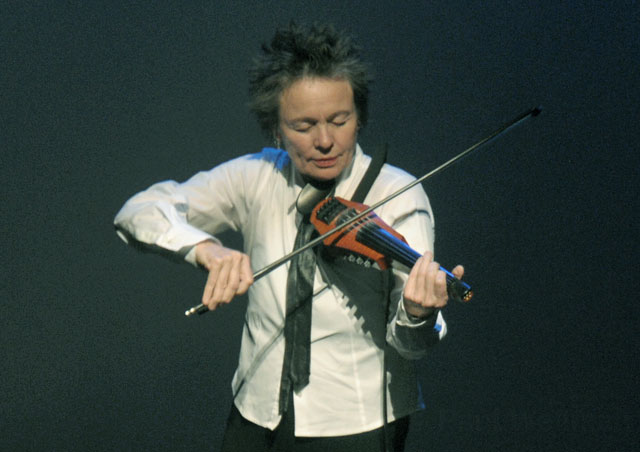Laurie Anderson at UCSB’s Campbell Hall
A Review of Dirtday! on Tuesday, October 23

A good story, some would say, needs a beginning, middle, and end — a kind of narrative blueprint. But Laurie Anderson rarely concerns herself with rules. At 65, she’s built her career on work that defies containment, which is of course key to her appeal. Yet with Dirtday!, her latest foray into storytelling, Anderson spins off in so many directions, it’s hard to stay with her over the course of this ninety-minute monologue.
The stage is littered with lit candles. Anderson walks on in her signature uniform of black slacks, white shirt, and black tie, her short grey hair arranged in a spiky halo. She picks up her electronic viola and begins to play. Dirtday! begins and ends with Anderson’s wonderfully resonant music: from one instrument she conjures a full, orchestral tone. In the middle, she tells stories, floating them on a bed of sound from viola and keyboard. Of course, Anderson sees speech itself as music, and uses her sonorous voice as an instrument in its own right. Yet the fact remains that Dirtday! consists of her talking — and talking — and talking, sending out a fog of prose that the listener must either attempt to navigate, or simply allow to blow past.
If there’s one unifying theme here, it’s the clouds of stage smoke that billow in from the wings, giving visual form to Anderson’s wispy, vaporous tales. There’s the story of the peacock as Darwinian nightmare; the story of visiting a tent city in Lakewood, New Jersey; the story of her late piano-playing rat terrier, Lolabelle. Then there are her philosophical musings: on dreaming, on regret, on pain. In nearly every case, there’s the seed here for deeper investigation and meaning making, yet Anderson chooses to muse rather than to probe, or to draw connections. The result is more free association than storytelling, and the lack of linkages keeps the audience at arm’s length.
Part of the challenge is the staging, or lack thereof: For nearly an hour, Anderson stands rooted at her lectern; eventually, she crosses the stage to sit in an armchair. The set is minimal; a single screen shifts from blue to red and back again. Meanwhile, her stories scud past like wind-driven clouds, or hover just long enough to dissipate into thin air.



